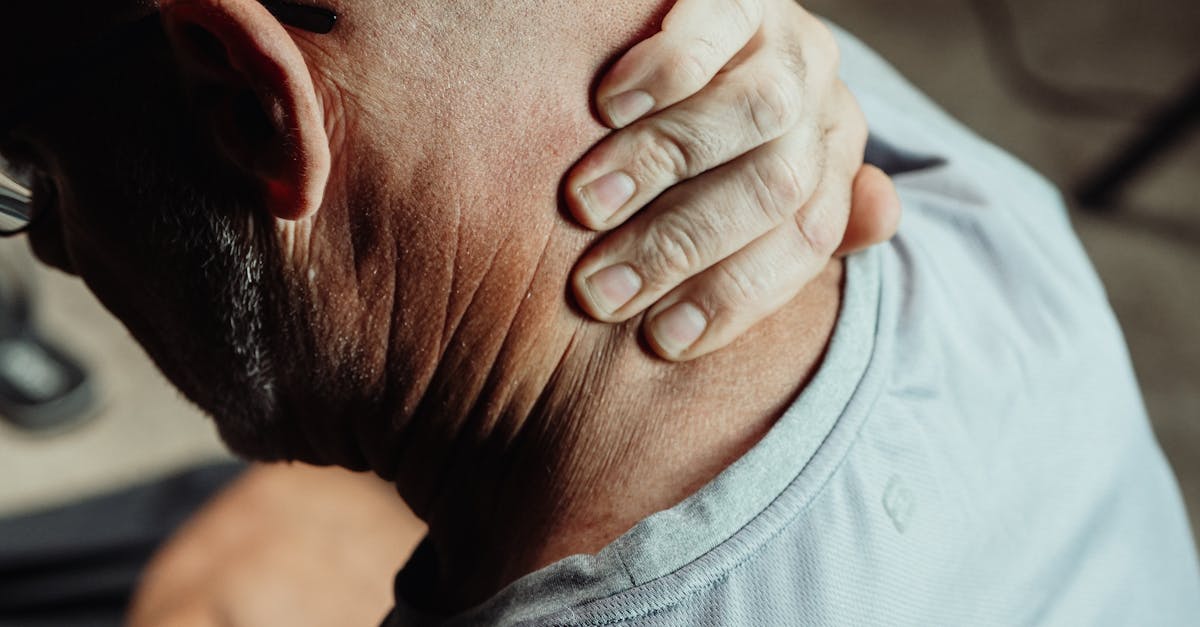In Short, understanding and managing chronic low back pain is crucial for those seeking to reclaim their quality of life. This approach emphasizes the importance of physical therapy and a tailored home exercise program to combat pain effectively. By incorporating mindfulness and diet changes, individuals can experience reduced discomfort and improved functionality. Emphasizing accessible treatment options, this method works by fostering mind-body awareness, guiding patients toward sustainable improvement and a more fulfilling lifestyle. |
Lower back pain is a prevalent issue that affects many individuals’ daily lives. To better manage this pain over the long term, it is essential to adopt a holistic approach that includes a combination of physical therapy, regular exercise, mindfulness techniques, and dietary changes. Maintaining correct posture and practicing safe lifting techniques can significantly reduce strain on the back. Furthermore, staying at a healthy weight and avoiding smoking are crucial elements in preventing back pain. Education plays an important role in empowering individuals with knowledge about their condition, leading to long-lasting relief and improved well-being.

Pulse Align introduces an innovative, non-invasive method that helps restore your body’s natural posture and balance through gentle, imperceptible pulses. This approach, which promotes overall well-being without focusing on discomfort or specific conditions, can lead to a reduction in muscle and joint tension while supporting the body’s own healing processes.
A Gentle Way to Wellness
At Pulse Align, we emphasize the natural ability of your body to recalibrate itself. By promoting muscle tone symmetry and enhancing overall posture, our method facilitates a holistic approach to well-being. Clients have reported improvements that often manifest as a greater sense of comfort and stability. We focus on helping individuals experience their full potential without direct reference to discomfort.
Personalized Client Experience
Our clients often share remarkable stories about their journeys toward improved wellness through Pulse Align. From alleviating neck and back tension to fostering a sense of balance and vitality, many find that engaging with our method brings about positive changes in their lives. We believe that everyone can benefit from our personalized approach that respects the unique needs of each person. Families, including children and expectant mothers, are welcome to explore our services as part of their overall wellness journey.
Explore Our Services
We invite you to visit our website to learn more about Pulse Align, find nearby locations such as La Prairie, Mont-Royal, and Terrebonne, and book a consultation for you or your family. Our services complement, but do not replace, medical care. We encourage you to maintain communication with your healthcare team while embracing a gentle approach to achieving improved posture and wellness.
Medical Disclaimer
The information on the Pulse Align website is for informational purposes only and should not be considered as a substitute for professional medical advice. Always consult with your healthcare provider for any medical inquiries.
Effective Strategies for Long-term Management of Lower Back Pain
- Physical Therapy: Engage in a tailored exercise program to strengthen muscles and improve flexibility.
- Mindfulness & Meditation: Practice mindfulness techniques to reduce stress and enhance relaxation.
- Posture Awareness: Maintain a correct posture to alleviate unnecessary pressure on the lower back.
- Weight Management: Keep a healthy weight to minimize strain on the back.
- Regular Movement: Incorporate physical activity into your daily routine to prevent stiffness.
- Dietary Adjustments: Focus on a balanced diet rich in anti-inflammatory foods.
- Education on Back Health: Gain knowledge about the mechanics of your back to foster pain management.
- Holistic Approaches: Consider therapies like chiropractic care or acupuncture as complementary solutions.

Managing Lower Back Pain: Long-term Strategies
Lower back pain can profoundly impact your daily life, making even simple activities challenging. Effective management over the long term requires a multifaceted approach. This article will explore several strategies, including physical therapy, lifestyle modifications, and stress management techniques to help you regain control over your pain and improve your overall well-being.
Physical Therapy and Home Exercise Programs
Exercise is foundational in managing chronic lower back pain. Engaging in a structured physical therapy program can help strengthen the muscles that support your spine, improve flexibility, and enhance overall functional mobility. Therapists often tailor programs to individual needs, which may include strengthening exercises, stretching routines, and stabilization techniques.
Incorporating home exercise programs into your daily routine can also be beneficial. Simple exercises like pelvic tilts, bridges, and core stability drills can be easily performed at home, ensuring consistent engagement with your recovery.
Mindfulness and Stress Reduction Techniques
Chronic pain can be exacerbated by stress. Integrating mindfulness and meditation into your daily practices can help reduce anxiety and improve your pain tolerance. Techniques such as deep breathing exercises, guided imagery, or progressive muscle relaxation can be effective in managing pain and promoting a sense of calm.
Furthermore, yoga and tai chi also provide a dual benefit—physical movement combined with mental relaxation—without placing excessive strain on your back. These practices cultivate body awareness and encourage gentle movement, which can alleviate tension and discomfort.
Dietary and Lifestyle Changes
Making conscious choices about your diet can also play a vital role in managing lower back pain. Consuming a balanced diet rich in anti-inflammatory foods—such as fruits, vegetables, whole grains, and fatty fish—can help combat chronic inflammation that contributes to pain. Staying well-hydrated and avoiding excessive alcohol and processed foods can further support overall health.
Maintaining a healthy weight is another crucial factor. Excess weight can place additional strain on your spine, exacerbating any existing pain. Engaging in regular physical activity and adopting a healthy diet can contribute significantly to weight management.
Understanding Posture and Ergonomics
Adopting proper posture during daily activities is paramount for long-term pain management. Whether sitting at a computer or lifting objects, employing safe techniques can significantly reduce the risk of exacerbating your lower back pain. It is important to be mindful of ergonomics in your workspace and home environment, ensuring that your seating and workstations promote a neutral spine position.
Regular breaks and switching positions throughout the day can also minimize stiffness and discomfort.
Education and Open Dialogue
Ensuring that you are well-informed about your condition can empower you to make better choices regarding your treatment. Engaging in patient education can provide long-term reassurance and reduce stress related to your pain. Communicating openly with healthcare providers, family, and friends can foster a support network that understands and respects your journey.
Be proactive in seeking resources, attending workshops, or reading up on recent findings related to chronic low back pain. Creating a knowledgeable environment for yourself will enhance your sense of control and understanding.
Lower Back Pain: Learn to Better Manage Pain Over the Long Term
| Management Strategy | Description |
| Physical Therapy | Engaging in tailored exercises can promote strength, flexibility, and overall body alignment. |
| Mindfulness & Meditation | Practicing mindfulness techniques can cultivate mental clarity and reduce stress, contributing to a balanced lifestyle. |
| Dietary Adjustments | Incorporating anti-inflammatory foods can enhance wellness and support bodily functions. |
| Posture Awareness | Maintaining correct posture throughout daily activities can reduce strain and improve overall health. |
| Regular Movement | Engaging in consistent physical activity promotes circulation and helps in recalibrating body mechanics. |
| Stress Management | Implementing techniques to manage stress can enhance emotional balance and alleviate physical tension. |
| Supportive Practices | Utilizing practices such as yoga or Pilates can aid in developing core strength and stability. |
| Community Engagement | Participating in supportive communities fosters a sense of belonging and shared experiences, promoting healing. |
| Holistic Approaches | Focusing on the whole body rather than isolated symptoms encourages comprehensive wellness and vitality. |
| Consistent Assessment | Regularly evaluating one’s body and activities can lead to better awareness and management of discomfort. |

Embracing Wellness: Client Testimonials on Their Journey to Managing Lower Back Pain
At Pulse Align, we have seen remarkable transformations among our clients who have embraced our holistic approach to managing lower back pain. Many have reported feeling significant improvements in their daily lives through our innovative treatments that support the body’s natural ability to recalibrate and restore balance. Our clients often express their gratitude for a program that aligns with their wellness journey.
One client from Châteauguay shared, “After my sessions at Pulse Align, I noticed a drastic change not only in my pain levels but also in my overall mood and energy. It feels empowering to have a say in my healing process!” Such testimonies underline the effectiveness of our tailored programs, which combine physical therapy, mindfulness, and lifestyle adjustments to enhance recovery.
Clients from Saint-Jérôme have also highlighted the community aspect of our services. “Knowing I am part of a supportive environment made a huge difference,” remarked a local resident. “Pulse Align helped me understand the importance of posture and exercise in managing my pain naturally.” This sense of belonging encourages them to stay committed to their recovery journey.
In regions like Les Escoumins, our services have become increasingly popular among those seeking to improve their well-being. A satisfied client mentioned, “I utilized Pulse Align’s various techniques, and I was pleasantly surprised at how quickly I began to feel better. My back pain no longer holds me back from activities I love!”
As our clients navigate their wellness journeys, they often find solace in understanding how holistic methods integrate into their lives. For instance, residents in Terrebonne appreciate our comprehensive approach that includes diet changes and ongoing education about pain management. One client stated, “Not only is my back pain diminishing, but I also feel more informed and in control.” This empowerment is a cornerstone of the Pulse Align method.
Our commitment to collaboration with healthcare teams ensures that our clients receive the best possible support throughout their journeys. Many local areas, such as Mont-Royal and Chicoutimi, have benefited from our partnerships, which help clients and their families to stay focused on their wellness goals. “Pulse Align has made a profound impact on the way I approach my health,” a client from Sainte-Marie shared. “They supported me in recognizing how simple changes could lead to lasting improvements.” This reflects our dedication to fostering an environment where achieving well-being becomes a reachable goal.
If you’re looking to restore balance and enhance your overall body function, our clinics in local communities are here to serve you. Discover how we can support your wellness journey by checking Our Clinics.
Lower Back Pain: Learn to Better Manage Pain Over the Long Term
Lower back pain is a prevalent issue that affects millions of individuals globally, often leading to significant discomfort and a decline in quality of life. Understanding how to effectively manage this type of pain is essential not only for alleviating symptoms but also for preventing future complications. A holistic approach towards managing lower back pain can lead patients to reclaim their lives and engage more fully in daily activities.
One of the most notable experts in this field is Dr. Sylvain Desforges, who has dedicated his career to healthcare innovation. As the founding president of TAGMED clinics and the ACMA association, Dr. Desforges combines expertise in osteopathy, naturopathy, and manual medicine to provide comprehensive care for those suffering from chronic pain, including lower back pain. His commitment to integrating advanced technologies into treatment protocols has paved the way for innovative practices in pain management.
The approach to managing lower back pain often begins with an individualized assessment, where healthcare providers, like Dr. Desforges, address the specific needs and concerns of each patient. This ensures that treatment plans are tailored and optimally aligned with the patient’s health goals. Physical therapy, in particular, is a cornerstone of this management strategy, emphasizing the importance of regular exercise to strengthen the back muscles, enhance flexibility, and improve overall physical function.
In addition to physical therapy, Dr. Desforges incorporates advanced treatment options such as spinal decompression, laser therapy, and shockwave therapy. These technologies are designed to alleviate pressure on the lumbar region, reduce inflammation, and promote healing. By leveraging these evidence-based treatments, patients can experience significant relief from pain, allowing them to return to activities they once enjoyed without limitations.
Nutrition and lifestyle changes also play a critical role in the management of lower back pain. A balanced diet can support overall health and mitigate inflammation, while maintaining a healthy weight is crucial to reduce strain on the back. Moreover, adopting safe lifting techniques and practicing proper posture can prevent the onset of pain in individuals at risk.
Mindfulness and restorative practices, such as meditation and yoga, are effective complementary strategies that can contribute significantly to long-term pain management. These approaches help to ease tension, reduce stress, and promote body awareness. When integrated with medical care, they can enhance the overall healing process for individuals suffering from chronic lower back pain.
Education and open dialogue with healthcare providers are paramount in managing lower back pain. Equipping patients with knowledge about their condition not only fosters reassurance but also empowers them to take an active role in their recovery journey. By participating in discussions about treatment options, patients can build a collaborative relationship with their healthcare teams, which is vital for optimal outcomes.
In summary, managing lower back pain requires a multifaceted approach that encompasses physical therapy, advanced medical treatments, lifestyle adjustments, and patient education. By following this comprehensive strategy, patients can effectively navigate their pain and work towards a healthier, more active life.
Neurovertebral Decompression Technology by TAGMED: A Pathway to Pain Relief
Mechanism of Action
The neurovertebral decompression technology offered by TAGMED operates by applying a controlled and gradual traction force on the spine. This innovative approach effectively increases the space between vertebrae, thereby alleviating pressure on intervertebral discs and nerve roots. As this pressure is mitigated, the circulation of fluids in the targeted area improves. This mechanism not only helps in the *reduction of inflammation* but also contributes to *pain relief*, creating a more conducive environment for healing.
Specific Advantages
This non-invasive method of treatment offers effective relief from chronic pain and associated symptoms of conditions such as herniated discs, disc bulges, and moderate to severe spinal or foraminal stenosis. By diminishing pressure on nervous structures and optimizing fluid circulation around the discs, neurovertebral decompression supports quicker recovery and significantly enhances quality of life for a broad spectrum of patients. Increased space around the affected areas can lead to sustainable pain reduction, allowing those suffering to engage more fully in their daily activities once again.
Comparison with Other Treatments
When compared to other therapeutic options commonly utilized to manage the aforementioned conditions—such as analgesics, corticosteroid injections, surgery, or traditional physical therapy—TAGMED’s neurovertebral decompression offers unique advantages. Notably, it avoids invasive interventions and minimizes the risks associated with medications. Additionally, patients often experience a faster recovery timeline, facilitating a more efficient return to their daily routines. This makes neurovertebral decompression an appealing option for individuals seeking effective pain management without the complications that can accompany surgical procedures or long-term medication use.
Case Studies or Testimonials
Numerous patients have shared their positive experiences following neurovertebral decompression treatment through TAGMED. Testimonials reveal significant improvements, such as lasting reduction in pain levels, swifter return to day-to-day activities, and a decreased reliance on pharmacological interventions. For example, one patient reported a notable decrease in chronic pain that allowed them to resume family activities they had previously been unable to enjoy. Another case illustrated a rapid recovery during the rehabilitation process, underscoring the efficacy of this holistic treatment approach. These real-life examples highlight the potential for neurovertebral decompression to transform the lives of those suffering from chronic pain.
Managing Lower Back Pain for the Long Term
Living with lower back pain can be an ongoing challenge, but with the right strategies, it is possible to effectively manage and reduce discomfort over time. Central to this management is a commitment to adopting a multifaceted approach aimed at rehabilitation and preventive care. Understanding the complex nature of lower back pain is critical, as it often stems from various factors including lifestyle, posture, and physical activity levels.
Physical therapy is a cornerstone in managing lower back pain, providing structured exercise programs that not only aim to alleviate current discomfort but also enhance strength and flexibility. Regular, targeted exercises can significantly improve overall spinal health, helping to relieve pressure on nerves and muscles. Additionally, maintaining a healthy weight through diet and exercise plays a pivotal role in reducing strain on the lower back.
Pain management techniques, including mindfulness and meditation, are equally important. These practices cultivate a deep sense of relaxation and awareness, allowing individuals to cope better with their pain. Incorporating mindfulness can alter the perception of pain, shift focus away from discomfort, and lead to improved emotional wellbeing.
Moreover, understanding and recognizing the importance of posture cannot be overstated. Poor posture can exacerbate back pain, so making consistent efforts to maintain a neutral spine during daily activities is essential for long-term management. Educating oneself about proper lifting techniques and ergonomics at work or home can drastically reduce the risk of aggravating existing pain.
Ultimately, embracing a proactive and informed approach to managing lower back pain can empower individuals to reclaim their lives, approach daily activities with confidence, and enjoy a higher quality of life despite the challenges posed by this common ailment.

Do you suffer from a chronic condition that responds little or not at all to conservative treatments?
At Pulse Align, we offer a unique, non-invasive solution designed to help restore your body’s natural balance and improve posture through gentle and imperceptible pulses. This innovative method not only promotes overall well-being but also can lead to reduced muscle and joint tension. By focusing on the body’s natural recalibration process, we aim to address discomfort and tension in a holistic manner, opening the door to a healthier, more fulfilling life.
It is essential to understand that Pulse Align does not directly target discomfort or unease, but instead supports your body’s ability to recalibrate itself naturally. Many clients report amazing improvements in their overall comfort and posture as their bodies respond to our gentle stimulation. Our approach is centered on promoting symmetry in muscle tone and enhancing functional balance, allowing you to experience a newfound sense of grace and ease in daily life.
Our commitment to a personalized approach means that each experience at Pulse Align is tailored to you. Clients often share remarkable testimonials highlighting their notable improvements in tension, flexibility, and overall wellness. Whether you are experiencing unease in your neck, back, or simply wish to enhance your body’s natural function, our gentle techniques create a supportive environment for positive change without the use of invasive measures.
We invite you to learn more by visiting the Pulse Align website, where you can find nearby locations in cities like La Prairie, Mont-Royal, and Terrebonne, and easily book a consultation for yourself or your family members. Remember, our services are designed to work alongside your existing healthcare team and do not replace medical care. If you are ready to take a step towards enhanced well-being, we encourage you to book an appointment online and explore the safe, non-invasive, and family-friendly approach that Pulse Align provides.
To learn more about our services and book an appointment, visit our website: Pulse Align.
Frequently Asked Questions
Low Back Pain, sciatica
- Do high heels worsen low back pain?Yes, they alter posture and increase lumbar pressure, exacerbating pain.
- Does a lumbar herniated disc always hurt?Not necessarily. Some hernias are asymptomatic, but if they compress a nerve root, they cause pain.
- Is physiotherapy needed after surgery?If surgery is performed, rehabilitation is essential to restore mobility, strength, and prevent recurrence.
- Is there a special brace for sciatica?No specific sciatica brace, but some lumbar supports can provide relief.
- How to choose a suitable mattress?A medium-firm mattress that adequately supports the lumbar area is often recommended.
- Can I prevent low back pain?By maintaining good posture, strengthening back muscles, maintaining a healthy weight, and lifting properly.
- Is ice useful for acute sciatica?Ice can reduce inflammation and acute pain initially, alternating with heat can be beneficial.
- Does acupuncture help?Some find pain relief with acupuncture, but effectiveness varies by individual.
- Can chiropractic care relieve sciatica?Some patients benefit from spinal adjustments by a qualified chiropractor.
- What are common causes of low back pain?A sudden strain, poor posture, excess weight, stress, disc wear, or weak muscles.
Louise Rousseau knows the toll low back pain can take on daily life—from struggling to tie your shoes to missing out on cherished activities. As a Low Back Pain Awareness Advocate at Pulse Align, Maryse blends compassion with the latest insights in pain relief to offer readers a trusted roadmap toward recovery. Her writing is shaped by heartfelt understanding and grounded in research, empowering others to navigate their own healing journeys. By fostering open dialogue and advocating for accessible solutions, Maryse champions a community where no one’s voice—or hope—is lost to pain.
Medical Disclaimer
The information and advice provided on this site do not replace the advice, diagnosis, or treatment of a healthcare professional. Please note that the author of this article is neither a doctor nor a specialist in a medical specialty as defined by the Collège des médecins du Québec. Manual medicine, functional medicine, and sports medicine as described on this site exclude any medical treatment or diagnosis made by a doctor or medical specialist. Always consult your doctor for any medical questions. For more details, please read our complete Legal Notice.
References
- Kamali, F., Sinaei, E., & Taherkhani, E. (2018). Comparing spinal manipulation with and without Kinesio Taping® in the treatment of chronic low back pain. Journal of Bodywork and Movement Therapies, 22(2), 540–545. https://www.sciencedirect.com/science/article/pii/S1360859217302085
- Köroğlu, F., Çolak, T. K., & Polat, M. G. (2017). The effect of Kinesio® taping on pain, functionality, mobility and endurance in the treatment of chronic low back pain: A randomized controlled study. Journal of Back and Musculoskeletal Rehabilitation, 30(5), 1087–1093. https://content.iospress.com/articles/journal-of-back-and-musculoskeletal-rehabilitation/bmr169705
- Luz, M. A., Sousa, M. V., Neves, L. A., Cezar, A. A., & Costa, L. O. (2015). Kinesio Taping® is not better than placebo in reducing pain and disability in patients with chronic non-specific low back pain: a randomized controlled trial. Brazilian Journal of Physical Therapy, 19(6), 482–490. https://www.scielo.br/j/rbfis/a/pSKxKdvNtdvGqRm55T9rVnS/
- Chang, N.-J., Chou, W., Hsiao, P.-C., Chang, W.-D., & Lo, Y.-M. (2018). Acute effects of Kinesio taping on pain, disability and back extensor muscle endurance in patients with low back pain caused by magnetic resonance imaging-confirmed lumbar disc degeneration. Journal of Back and Musculoskeletal Rehabilitation, 31(1), 85–93. https://content.iospress.com/articles/journal-of-back-and-musculoskeletal-rehabilitation/bmr169681
- Sarkar, N., Sarkar, B., Kumar, P., Laha, K., & Patel, L. (2018). Efficacy of kinesio-taping on pain, range of motion and functional disability in chronic mechanical low back pain: a randomized clinical trial. International Journal of Health Sciences & Research, 8(7), 105–112. https://www.academia.edu/download/87285818/my_research_on_low_back_pain.pdf
- Pakkir Mohamed, S. H., Al Amer, H. S., & Nambi, G. (2023). The effectiveness of Kinesio taping and conventional physical therapy in the management of chronic low back pain: a randomized clinical trial. Clinical Rheumatology, 42(1), 233–244. https://doi.org/10.1007/s10067-022-06352-3
- de Brito Macedo, L., Richards, J., Borges, D. T., Melo, S. A., & Brasileiro, J. S. (2019). Kinesio taping reduces pain and improves disability in low back pain patients: a randomised controlled trial. Physiotherapy, 105(1), 65–75. https://www.sciencedirect.com/science/article/pii/S0031940618301548
- AlBahel, F., Hafez, A. R., Zakaria, A. R., Al-Ahaideb, A., Buragadda, S., & Melam, G. R. (2013). Kinesio taping for the treatment of mechanical low back pain. World Appl Sci J, 22(1), 78–84. https://www.researchgate.net/profile/Ashraf-Hafez-3/publication/328275215_Kinesio_Taping_for_the_Treatment_of_Mechanical_Low_Back_Pain/links/5c6751e192851c1c9de4567b/Kinesio-Taping-for-the-Treatment-of-Mechanical-Low-Back-Pain.pdf
- Ogunniran, I. A., Akodu, A. K., & Odebiyi, D. O. (2023). Effects of kinesiology taping and core stability exercise on clinical variables in patients with non-specific chronic low back pain: a randomized controlled trial. Journal of Bodywork and Movement Therapies, 33, 20–27. https://www.sciencedirect.com/science/article/pii/S136085922200122X
- Artioli, D. P., & Bertolini, G. R. F. (2014). Kinesio taping: application and results on pain: systematic review. Fisioterapia e Pesquisa, 21(01), 94–99. https://www.scielo.br/j/fp/a/LTrVSBPGCpYv7Z9ntV4VpwB/?lang=en



